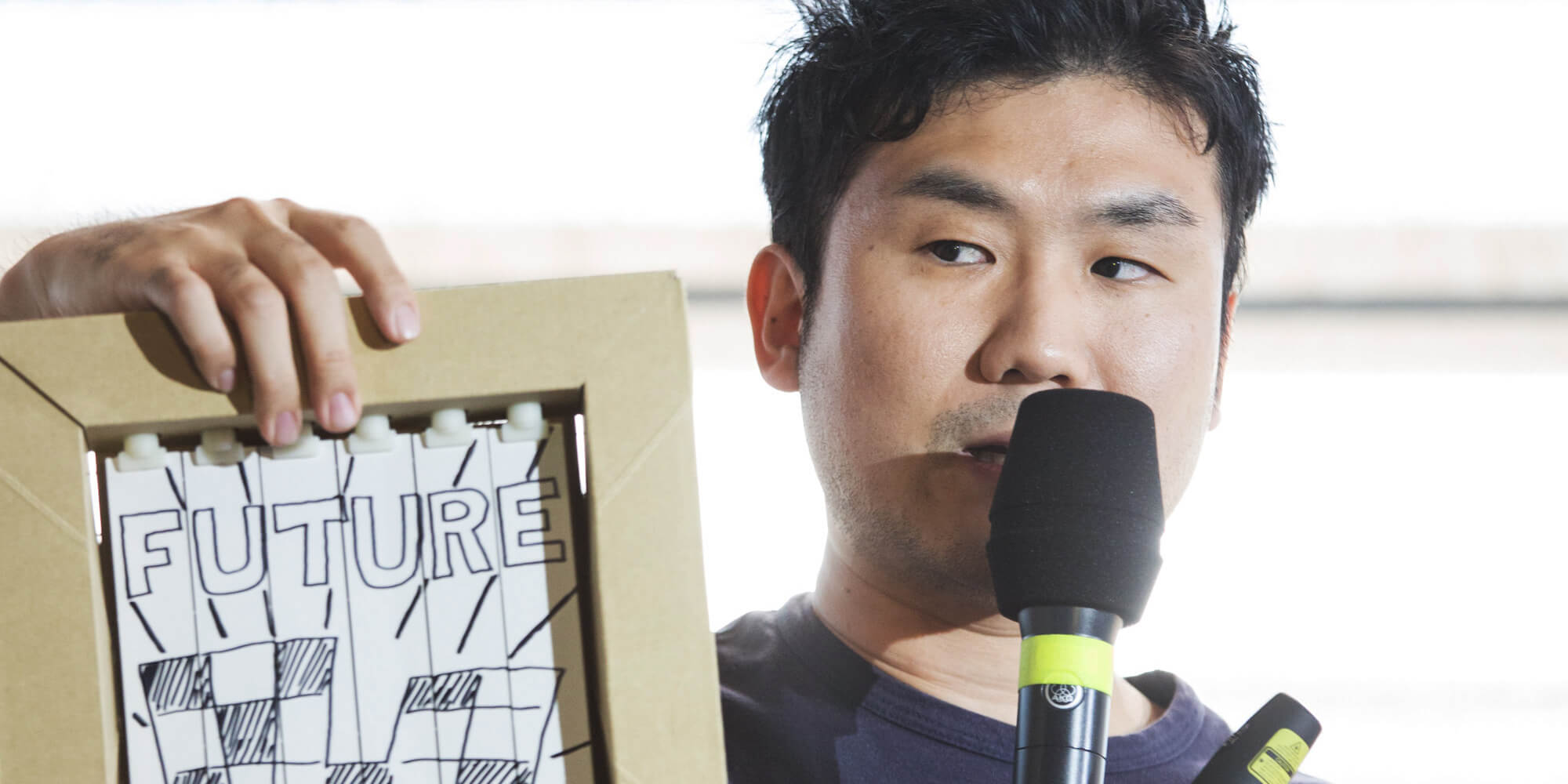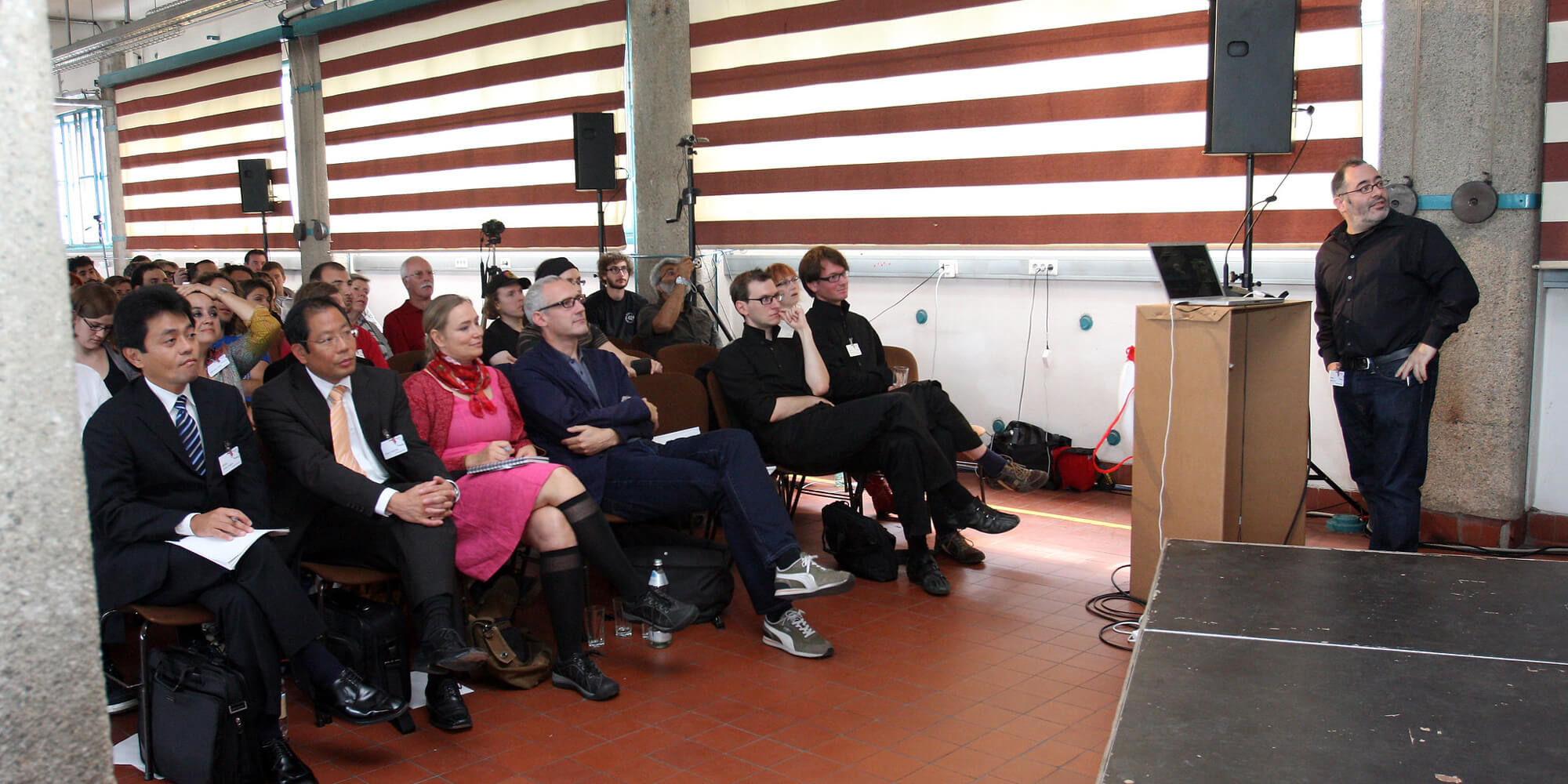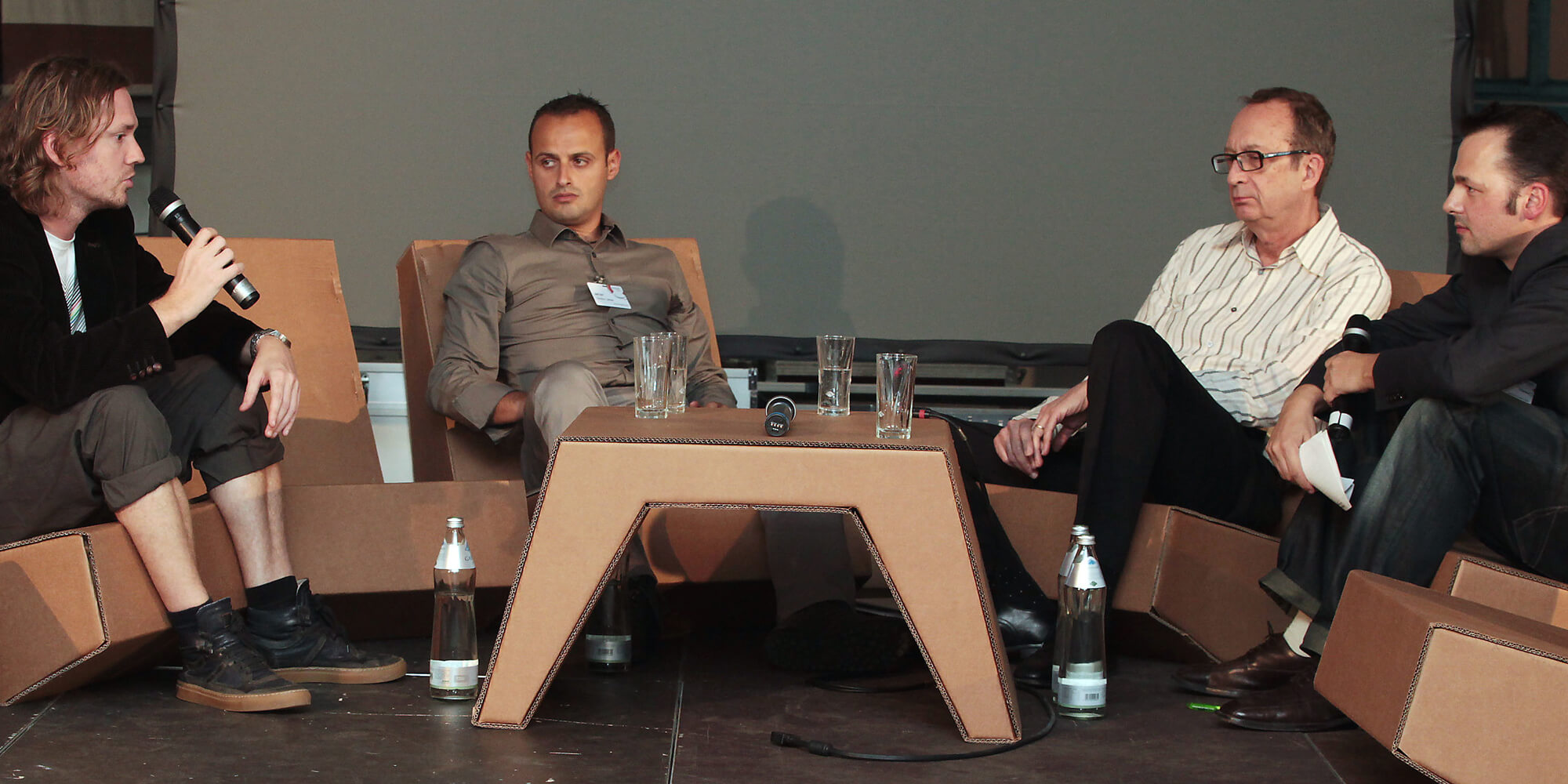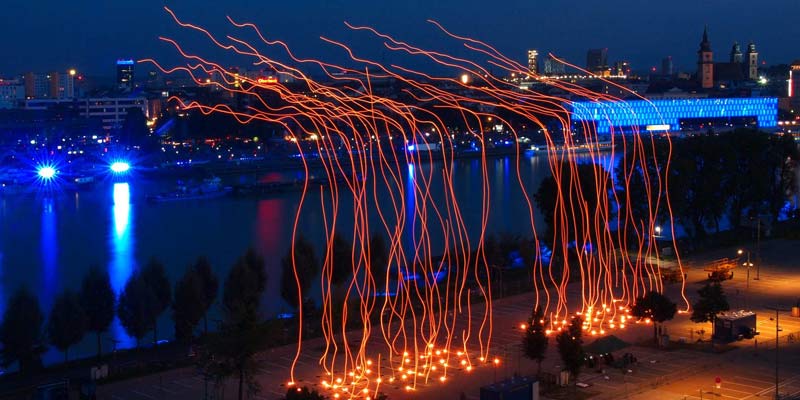Pixelspaces was an annual conference that the Ars Electronica Futurelab staged between 2001 and 2013. It was succeeded in 2018 by the Open Futurelab, an annual glimpse behind the scenes of the Ars Electronica Futurelab that continues to this day.
Pixelspaces popped up on varying locations around Linz and included symposia and exhibitions that dealt with various current issues in the area of digital culture. As a place for networking and presenting current research approaches at the boundary between art, science, technology and society, they served as an important platform for a transdisciplinary community of artists, researchers from emerging and established media labs, and experts from a wide range of other disciplines.
The programmatic point of departure of Pixelspaces was delivered by the increasingly complex interconnections among experimental fields and concrete tasks being carried out in the fields of computer gaming, architecture and virtual/augmented reality. The conference focused on, negotiated and even provoked new efforts to transcend boundaries between different artistic and scientific disciplines.
Accordingly, non-institutionalized individual manifestations of interdisciplinarity not only provided the themes of the annual Pixelspaces conferences; the trend as a whole also occupied the focus of attention. Pixelspaces served as a pioneering platform for digital culture and its exploration.
2001: Pixelspaces
The first Pixelspaces conference featured theoretical papers and illustrative works by various proponents of virtual reality that dealt with new approaches to the development of hardware and software applications. Parallel to this, the Pixel + Spaces project examined facts & circumstances of relevance to architects and visualization engineers as they go about engendering real and virtual experiential spaces.
2002: Transplanted Interactions
The symposium focused on the design of interactive environments that are methodologically relevant in architecture, game development and augmented reality. This methodology is based in the broadest sense on interaction as conceptual objective. The point of departure of the thematic confrontation with respect to practices these fields have in common were possibilities and especially instances of the interweaving of the three areas as evidenced by examples of exhibition architecture.
2003: Dampf-Sensory Environments-Immaterial Interfaces
The point of departure was provided by convergence tendencies exhibited by the classic arts and avant-garde media art. On the basis of current projects and concepts, corresponding artistic and technical methods of accomplishing this process of convergence were investigated. Thus, conference participants looked into the extent to which institutions in traditional fields of the arts such as music and dance theater (can) display readiness to take media-aesthetic implications into account. The Kultur 2000 project Dance and Media Performance Fusions set up a direct relationship between theory formation, practical testing and real performance.
2004: Transfer
Media artists and representatives of art & media labs from around the world discussed the question of the extent to which artistically intended strategies can impart impetus to extra-artistic areas when it comes to developing new interaction concepts and putting new technologies to use.
2005: Hertzblut
The conference dealt with the provocative relationship between emotions and computer technology and focuses attention on forms of dealing with emotions in the context of human-machine interaction. Findings in the field of neurobiology and research into emotions as well as experience yielded by project-based applications provided approaches to issues from two directions: the extent to which machines are capable of understanding emotions, reflecting them or processing forms of human emotions; and the extent to which machines themselves can develop forms of emotional intelligence.
2006: Goblin City
Pixelspaces 2006 investigated which traces digitization was leaving on the cityscape — in other words, how characteristics of media are being imparted to architecture, and how enhancements like telematic furnishings and location-based services can turn buildings’ interiors into expanded spheres of communication. Conference participants presented projects and approaches at the nexus of media, art and the public sphere.
2007: Onfield
In 2007, Pixelspaces discussed functions currently being performed online for the formation of virtual communities, and possible ways of transferring them into the physical sphere of everyday life. Connected to this was the question of the consequences for perception and use of this space as a publicly accessible and usable storehouse of multi-medial information fragments and information levels. The expansion of “being online” into “onfield community” was treated on the basis of a variety of approaches — from micro-blogging to GPS-based games, from strategies to collective intelligence to public interfaces.
2008: Pixel-Spaces
International R&D facilities and labs that engage in teaching and work at the interface of artistic-creative media production and technological research discussed innovation effects that result from temporary assignment formats. The discussion is based on the hypothesis that the temporary integration of freelance creatives into an enterprise’s workforce can establish a new rhizome-like enterprise culture that can yield successful strategies in opening up innovative market segments and niche markets.
2009: Do-It-Together!
The conference was dedicated to the art of new and not-yet-institutionalized interdisciplinary crossovers, and scrutinized resulting poetic forms of expression. “Do-It-Together!” focused on art and science before the backdrop of converging technologies as well as other disciplines such as Green technologies. The new conference format: a nomadic symposium taking place along the topography of the facility’s exhibitions and installations.
2010: Labs as repair shops?
Will labs devote greater effort to social and civil entrepreneurship in the future? The Pixelspaces conference took up and discussed several of the many initiatives in this area. This part of Pixelspaces 2010 scrutinized the future of labs in the light of changing framework conditions and elaborated on the extent to which laboratories can function as the “repair shops” of our world.
2011: Re-Scripting
Re-Scripting is a term used by scholars in the humanities to describe the active modification of the meaning of concepts, objects, locations, relationships, etc. as a result of personal and social actions. A wide array of variations on the innovative methods used in the Futurelab in the spirit of “shared creativity” is applied in the general context of art and science. This was expressed by the re-scripting of the term “research”. Pixelspaces 2011 was focusing on this latest paradigm shift at the interface of art and research, and discussing its implications for art, science and society.
2012: Pixelspaces
For Pixelspaces 2012, the Ars Electronica Futurelab was opening its doors to provide attendees with behind-the-scenes insights into various projects among them (St)Age of Participation, openAIR, Voyage of Discovery. Another one was a program that dovetailed nicely with the scholarly orientation of the Pixelspaces conference: Ars Electronica’s new artist- & scientist-in-residence concept.
2013: Pixelspaces
Two highlights of Pixelspaces 2013 were Inside Ars Electronica Futurelab and Inside Ars Electronica Solutions, close-up looks at current projects of the Ars Electronica Futurelab and the Ars Electronica Solutions division set up in 2012. One very high priority effort was Spaxels, which had been substantially enhanced and upgraded over the past year. Insiders also presented a few of their international joint ventures, including those being staged in conjunction with the Ars Electronica Residency Network and the Lab Academy.
Credits
Ars Electronica Futurelab (2001-2013): Shervin Afsharazad, Daniel Aigenbauer, Roland Aigner, Tamer Aslan, Michael Augustyn, Johannes Bauer-Marschallinger, Florian Berger, Sigrid Blauensteiner, Bernhard Böhm, Chris Bruckmayr, Cecile Bucher, Mar Canet-Sola, James Cochrane, Florina Costamolnig, Manuel Dobusch, Elba Carolina, Eguizabal Garcia, Stefan Eibelwimmer , Ewald Elmecker, Barbara Erlinger, Viktor Fillo, Peter Freudling, Stefan Fuchs, Matthew Gardiner, My Trinh Gardiner-Müller, Imanol Gomez, Ramsy Gsenger, Clemens Häckel, Bernd Haid, Roland Haring, Kathrin Hausberger, Sophie Kristin Hausberger, Yvonne Hauser, Stefan Hehr, Barbara Hinterleitner, Christoph Grodi Hofbauer, Peter Holzkorn, Martin Honzik, Horst Hörtner, Andreas Jalsovec, Petros Kataras, Michael Knoll, Fadil Kujundzic, Daniela Kuka, Anna Kuthan, Ines Lassacher, Daniel Leithinger, Marina Lenger, Christoph Liebmann, Christopher Lindinger, Martina Mara, Pascal Maresch, Johanna Mathauer, Benjamin Mayr, Maria Mayr, Michael Mayr, Kathrin Meyer, Kristefan Minski, Stefan Mittlböck-Jungwirth-Fohringer, Michael Mondria, Martin Mörth, Harald Moser, Patrick Müller, Otto Naderer, Nicolas Naveau, Ali Nikrang, Katharina Nussbaumer-Greiderer, Kathrin Obernhumer, Dietmar Offenhuber, Emiko Ogawa, Hideaki Ogawa, Martina Ohl, Benjamin Olsen, Michaela Ortner, Veronika Pauser, Dietmar Peter, Maria Pfeifer, Michael Platz, Irene Posch, Andreas Pramböck, Robert Praxmarer, Gerald Priewasser, Gabriele Purdue, Erwin Reitböck, Roland Reiter, Vanessa Schauer, Roland Schmidt, Bianca Schober, Alexa Steinbrück, Dieter Steininger, David Stolarsky, Claudia Wall, Daniel Wilcox, Markus Wipplinger, Mahir Yavuz, Claus Zweythurm
Related Projects
Take a look at some of our other projects
From our never-ending list of ideas and concepts we have compiled a selection of works related to the topics addressed in this project. An overview of all our productions, cooperations and projects can be found in our continuously growing project archive.





